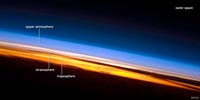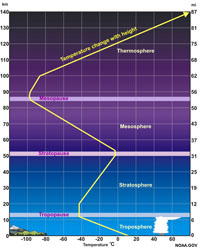8.1: Atmospheric Circulation
- Page ID
- 10262
Atmospheric Circulation
Our atmosphere is the gaseous mass or envelope surrounding the Earth, and retained by the Earth's gravitational field. Other planets and moons in the Solar System have atmospheres. The atmosphere plays many important roles in moving water in the world's ocean basins, and for supporting life on Earth!
Earth's atmosphere is:
- Density stratified - air is compressed and most dense near the surface and grows increasingly rarefied skyward.
- About 100 kilometers thick between the ocean/land surface and the vacuum of space.
- Composed mostly of gases, mostly nitrogen (as N2) and oxygen (as O2), and trace amounts of other gases (including CO2, argon, water vapor); and traces of liquids and solids in suspension or falling as precipitation: suspended water (clouds, water droplets and ice crystals), traces of organic compounds, and suspended particles of dust from a variety of sources.

Figure 8.1. Layers of the Earth's atmosphere as seen from space.
Structure of the Atmosphere
The Earth's atmosphere is subdivided into levels (Figure 8.2):

Figure 8.2. Structure of Earth's atmosphere.
| * The troposphere is the lowest portion (up to about 6-8 miles [10-13 km]) where all weather takes place and contains about 80% of the air's mass and 99% of water vapor. |
| * The overlying stratosphere contains an abundance of ozone which absorbs ultraviolet radiation, protecting life on land and in the shallow ocean extends up to about 31 miles (50 km). |
| *The mesosphere is the part of the earth's upper atmosphere above the stratosphere in which temperature decreases with altitude to the atmosphere's absolute minimum. |
| * The thermosphere the region of the atmosphere above the mesosphere and below the height at which the atmosphere ceases to have the properties of a continuous medium (about 60 miles [100 km]). The thermosphere is characterized throughout by an increase in temperature with height, where the charged atomic particles of the solar wind begins to interact with atmospheric gases. |
Energy Transfer Through the Atmosphere
The amount of energy coming into the Earth from the Sun is equal to the energy reflected and radiated back into space. The atmosphere, oceans, and land absorb and release energy. Living things also absorb and release energy. Some of the energy stored in organic matter is preserved when it is buried in sediments. Geothermal energy is also a trace of the energy radiated into space. The rate of energy transfer also varies due to cloud cover and ice and snow coverage.
Incoming solar radiation involves all wavelengths of the electromagnetic spectrum. Figure 8.3 shows the wavelengths and intensity of solar energy striking the top of the atmosphere and the energy reaching the surface. The atmosphere is transparent to most wavelengths, but part of the solar spectrum are absorbed by certain greenhouse gases in the atmosphere including water vapor, carbon dioxide, ozone, methane, and other gases. Shorter wavelengths (UV and blue light) is diffused in the air—making the sky blue. Longer wavelengths are less diffused—making sunsets and sunrises red (Figure 8.4).
Energy that is not reflected back into space is radiated back into space in wavelengths longer than visible light (mostly in the thermal infrared portion of the electromagnetic spectrum).
 |
 |
| Figure 8.3. Wavelengths of solar energy transmitted and absorbed by the atmosphere. | Figure 8.4. Energy transfer through the atmosphere |
Composition of the Atmosphere
• Nitrogen (N2) - 78%
• Oxygen (O2) - 21%
• Argon - 0.9%
• Carbon Dioxide (CO2) - 0.036%
• Others < 1 % - Neon, Helium, Methane (CH4), Krypton, Hydrogen (H2), traces of other compounds
Other trace gases in variable amounts include nitrogen oxides, ozone (O3), sulfur dioxide, hydrocarbons, and more. These gases are released by volcanic eruptions, lightning, wildfires, erosion, and pollutants of many kinds from human activity. Major sources of air pollutants included gases and smoke released by fossil-fuel energy consumption, industrial releases, agriculture, and leaks of refrigerator and air conditioner coolant compounds.



